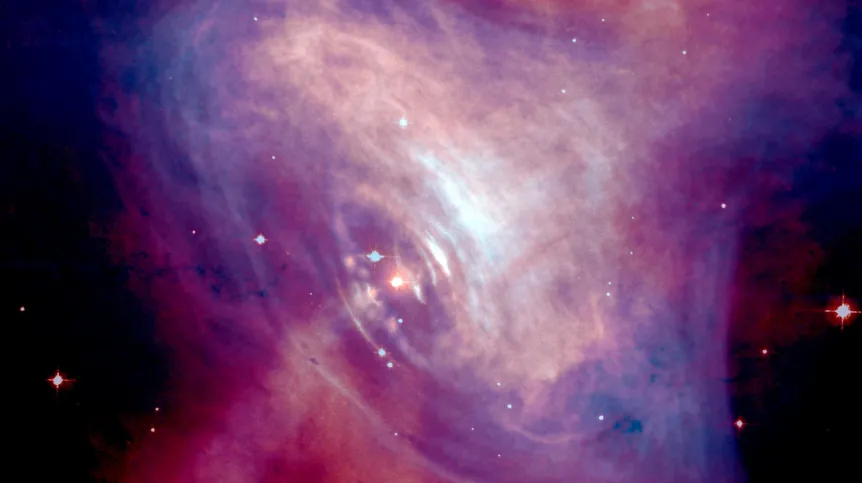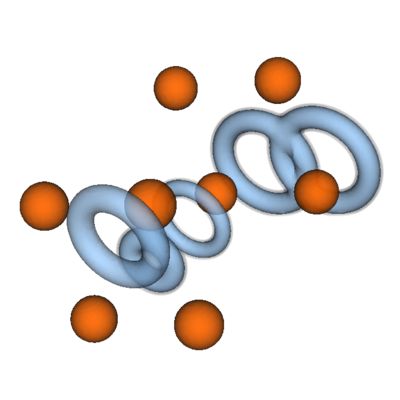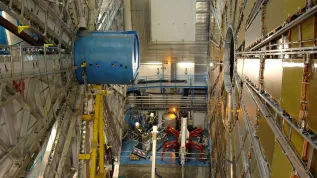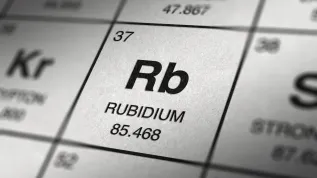
Scientists from Poland have developed a program that simulates the behaviour of matter in the inner shell of neutron stars. The program takes into account quantum effects, including superfluidity. This research allows to better understand how macro-scale phenomena emerge from the laws of quantum physics of the microworld.
Neutron stars (including pulsars) are stellar grandparents - the final stage of the evolution of large stars. However, admittedly, they are grandparents with a rich inner life. A neutron star can have the mass of two Suns, but is extremely dense: it is squeezed into a sphere with a radius of 10 km, which is less than Warsaw. Extremely high pressures prevail: as if you could fit 3 billion 2-ton cars (more than all the cars in the world) in a matchbox. The temperature is one billion degrees Celsius, and the star can rotate 30 times per second.
NEUTRON SOUP
The outer shell of the star has a crystalline structure. However, the deeper you go, the stranger things get: at extreme pressures, neutrons, which make up the atoms that make up the star, 'leak' from the cores and create a superfluid homogeneous neutron fluid in the heart of the star.
The greatest simulation challenge is the transition stage between the outer shell and the homogeneous part of the neutron star. Daniel Pęcak, PhD, from the Institute of Physics of the Polish Academy of Sciences compares it in an interview with PAP to a crystal made of atomic nuclei immersed in a soup of superfluid neutrons. His team undertook the quantum description of this physical system. The results were published in Physical Review X.

NEUTRONS LEAK FROM ATOMIC NUCLEI
The researcher explains that protons, which are positively charged, repel each other. At high pressures, they have enough: they combine with electrons to form electrically neutral neutrons. As a result, very exotic isotopes 'packed' with neutrons are created. Such an abundance of neutrons in the heart of the star means that it actually deserves to be called a 'neutron star'. At some point, adding another neutron to the atomic nucleus is too much - it ceases to be bound to the nucleus, leaks into the space between the nuclei and creates a superfluid component. In the inner shell of a neutron star there is such a strange quantum mixture of exotic nuclei in crystalline form and superfluid neutrons.
'To understand the dynamics of a lake, it is not enough to know what is happening in a droplet of water', Pęcak says. He compares atomic nuclei to droplets of nuclear matter. A neutron star is not a droplet, but several kilometres of material in which the nuclei are part of a larger structure. The scale of matter is important here. This is a completely different system than the one we deal with around us and describing it is not easy.
To find out what is happening in such a neutron soup from the point of view of quantum mechanics, very complicated calculations have to be performed. You cannot distinguish a neutron that is in this superfluid from a neutron that is bound in the nucleus of an isotope. So you have to simulate the behaviour of thousands of particles simultaneously. This requires huge supercomputers that solve several hundred thousand coupled equations simultaneously.
PULSAR GLITCHES
The research will allow to better understand pulsars. Pęcak explains that pulsars emit a beam of radiation from their poles, one that can be sometimes observed from Earth. They are treated as very precise timers, lighthouses that flash at precisely defined intervals. There are ideas to use them as 'space GPS systems' that will allow to measure time and location during space travel.
The problem is, for example, that a 'glitch' sometimes occurs in the rotation of a pulsar - an irregularity when the signal appears at a different time than expected.
Pęcak explains that the superfluid interior of a star, moving without resistance, moves at a different speed than its crystalline shell. Every so often there is a jump in angular momentum between these centres. Without simulating what is happening inside the stars, it will be impossible to better understand these glitches. If we want to understand why a pulsar sometimes 'ticks' at a strange rhythm, we need to understand what is happening inside it - also at the microscopic level.
As part of the work, the researchers created open-source software and determined some properties of the material from which neutron stars are built. The model also includes quantum effects, which contribute to an interesting effect: the formation of vortex rings, which can have a significant impact on the dynamics of the entire star.
'This research makes me realize how universal physics is. Neutron stars have huge densities, while ultracold atomic gases are many times thinner than air. Despite these differences, exactly the same phenomena occur in both systems: superfluidity are the presence of quantum vortices', the researcher says.
The research was conducted at the Warsaw University of Technology using the PLGrid infrastructure and access to the LUMI supercomputer, and its implementation was financed by the Polish National Science Centre (NCN).
PAP - Science in Poland, Ludwika Tomala
lt/ agt/













